NOTES ON ART, COLONIALISM, and SHEETS OF PAPER
Pablo José Ramírez
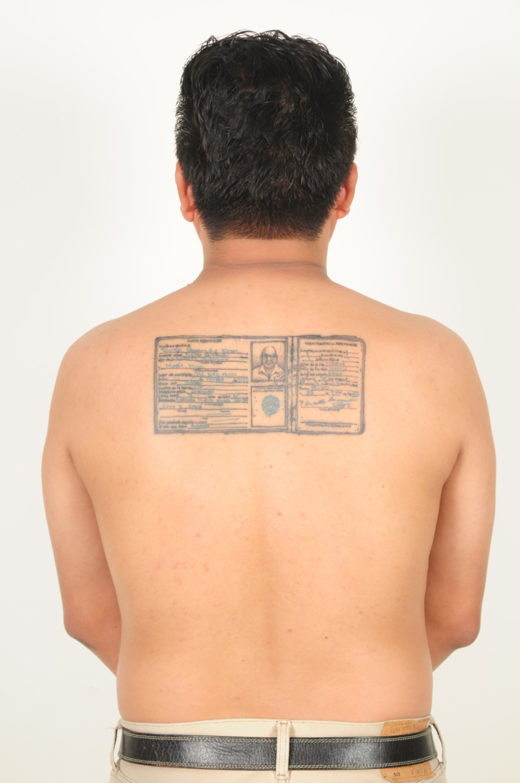 Benvenuto Chavajay Doroteo Guamuche, 2013 Photographs, tattoo, name reclamation campaign
Benvenuto Chavajay Doroteo Guamuche, 2013 Photographs, tattoo, name reclamation campaign
When interviewing the athlete, the North American press found it difficult to pronounce his indigenous name, and a reporter decided to name him Mateo Flores—a name that the athlete would continue to use to identify himself before the international press. Upon his return to Guatemala, he was welcomed with an official award from the government of Jacobo Arbenz Guzman1, and, among other accolades, public recognition from the United Fruit Company.2 To honor the athlete’s triumph, the government inaugurated the previously known Estadio de la Revolución (Revolution Stadium) as the Mateo Flores National Stadium.3
In 2014, over 50 years after the athlete’s victory in the Boston marathon, Guatemalan artist Benvenuto Chavajay presented a work tiled “Doroteo Guamuch.” In a country with strong racist characteristics, Chavajay’s work is no less titanic than the triumph of the athlete it is named after: it proposes a new law to change the name of the national stadium to Doroteo Guamuch Flores National Stadium. The project is thought of as an artwork that had no choice but to overflow its very parameters and be shaken by what would happen a few years later. As part of the work, the artist tattooed the athlete’s national identity card on his back.
Benvenuto Chavajay is a Guatemalan visual artist, although if asked, he would possibly answer—with a certain degree of sarcasm—that he is more of a chunchero 4 than an artist, more small town than big city, and of course, how can it be otherwise! Admitting to anything else, he would be acknowledging the predominance of the hegemonic western system of art legitimation. Chavajay is one of the most prominent artists of the country and the region, with a solid body of work that fuses with his family history, his Tzuthuhi’l language, and his native town San Pedro La Laguna, on the shores of Lake Atitlan. His work comes and goes in time, encircling and folding it. For this artist, lineal history does not make much sense. As he has declared many times; his past is in front of him; it’s looking for his lost belly button, for the vestiges of an ontology that exists at a distance from the modern Guatemalan subject. 5
In August 2016, after a long process of advocacy and meetings, and running through the tiresome bureaucracy of the Congress of the Republic, decree 42-2016 was approved. The stadium would be renamed. The negotiations were led in the political arena by the leftist congressman Miguel Angel Sandoval.6
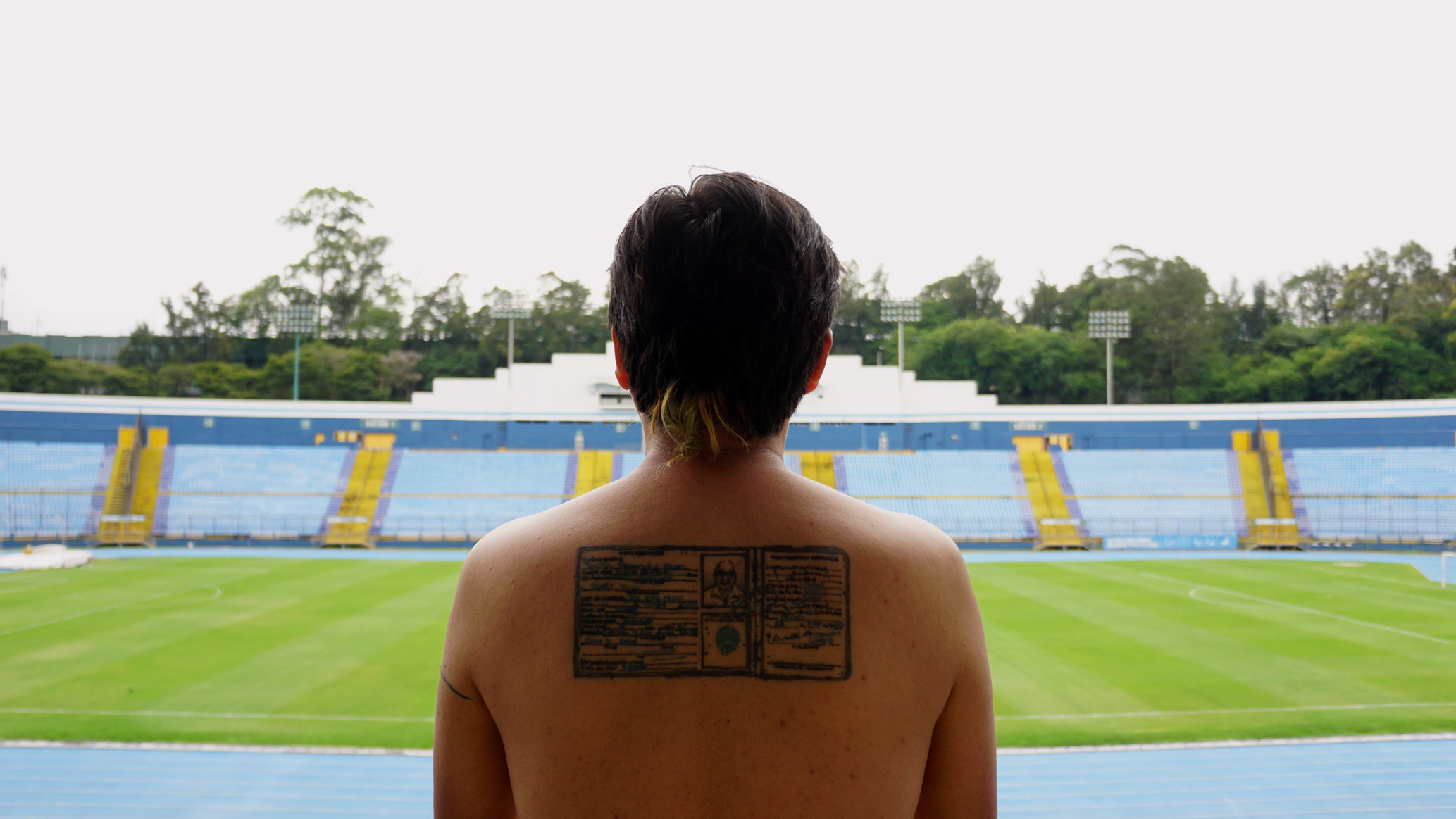
Benvenuto Chavajay, Doroteo Guamuche, 2013. Photographs, tattoo, name reclamation campaign. View of the Stadium.
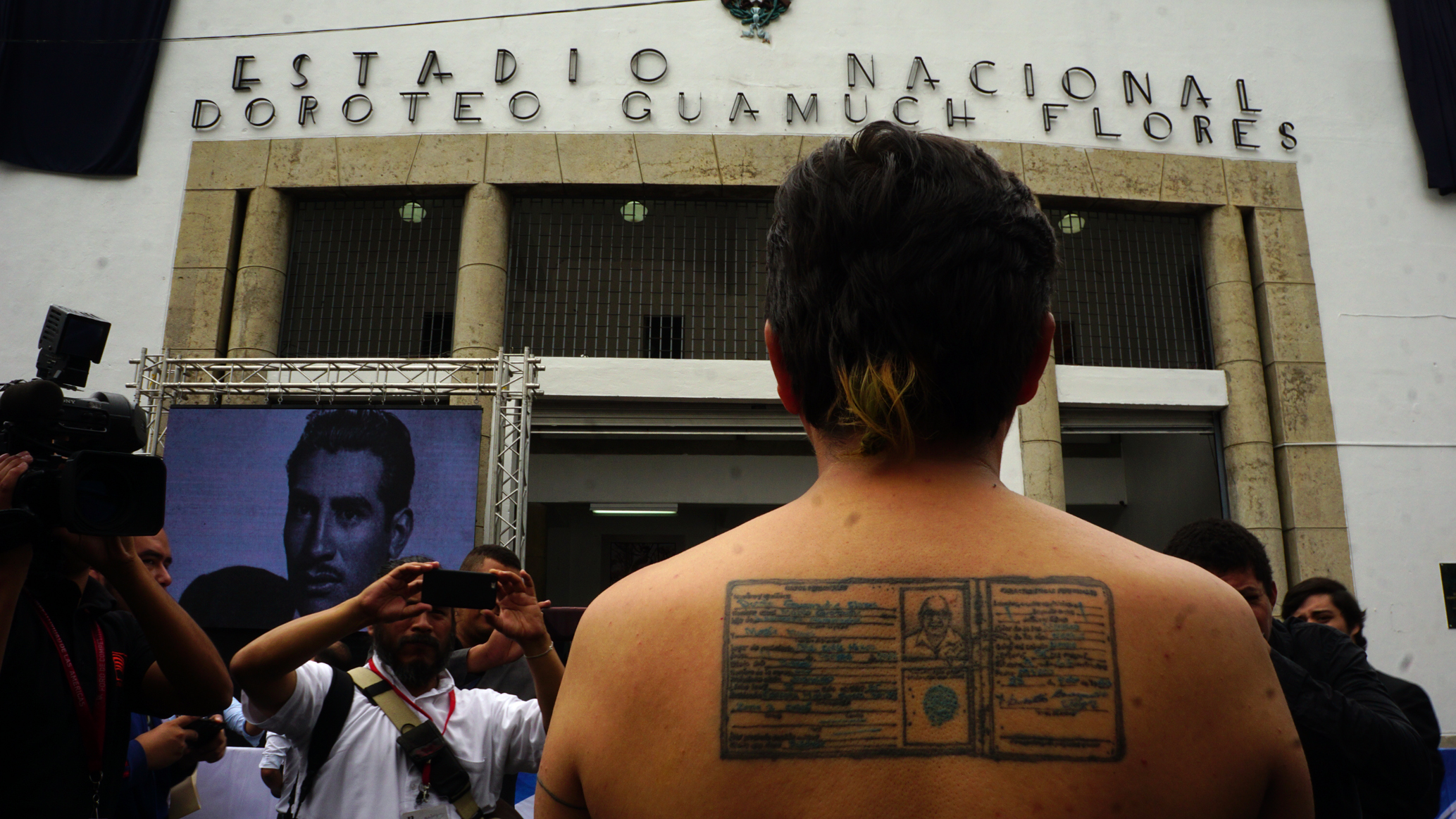
Benvenuto Chavajay, Doroteo Guamuche, 2013. Photographs, tattoo, name reclamation campaign. With renamed stadium.
It is in relation to this history that the work of Benvenuto develops, moving in arrhythmic variations through times of continuity and discontinuity. However, what is it that is truly relevant in Benvenuto’s work? Where does the work begin and where does it end? In addition, and more importantly, why does the issue of aesthetics continue to be significant in this discussion?
The number of texts on art and historic memory is vast, but in this text I am interested in the relation established between the aesthetic (art phenomena) and a certain performativity of history (rhythms, duration, and time). I’m interested in thinking about how certain temporary synchronies fold history like a sheet of paper, making the delimitations of present, past, and future hazy, and, along the way, build a contemporary notion of time.
On the other hand, it is important in this conversation to attempt to think of an amplified or extended art object—not reduced to a museographic-work or an art-object, but an aesthetic event that is located in the hazy time of contemporary history. It is only then that things become a bit more interesting.
The second important vector, to think of these relations is linked to the form in which the meanings of words move, acquire other meanings: the time of ideas is not the same as that of objects. Art, therefore, depends on a time-idea that transforms itself as it transforms the art object, extends it beyond its parameters. The creole idea of the Indigena, the Indigenous, (as the place of the uncivilized) is without a doubt one of the founding racist and colonial concepts of the Guatemalan nation. It is precisely this idea that is shaken up in a vertiginous way in the work of Benvenuto Chavajay and also in that of various other artists in the country and region, which I will unfortunately not be able to analyze in this text.
In many examples of science fiction cult cinema, time is linked to recurrence. Travels in time through strange vintage machines, secret chambers, cyborgs, and quantic holes have brought forth this strange popular fascination with time. It’s as if the present is so suffocating that we need to think about the promise of other times.
Slavoj Zizek asserts that it is easier to think about the end of the world than the end of capitalism. This may explain the current fascination with the post-apocalyptic zombie world. It is easier to think about the end of things through time travels than about the end of an unwanted present in the here and now, because what is missing is an ethical horizon, because the weight of the Present is too great, because the rhythm of time is slow, because the durations seem eternal, and because human will is overwhelmed before the immensity of Time in contrast with the short and fragmented daily experience of the modern-capitalist individual.
After news of the stadium’s name change began to circulate, someone asked me: What would Doroteo Guamuch think about this? Maybe the question is less relevant than acknowledging the importance of his name as a symbol, which was itself sabotaged by an artist who has assumed it, the way it has functioned, as his own dilemma. What is transformed is an idea. In that sense, there is an intersubjectivity in time that becomes manifest in the work of an artist, but also in the work of an intellectual, an activist, or a social movement. The work exceeds its author and cannot be reduced to an object, whether it be a performance or a “long duration” piece.
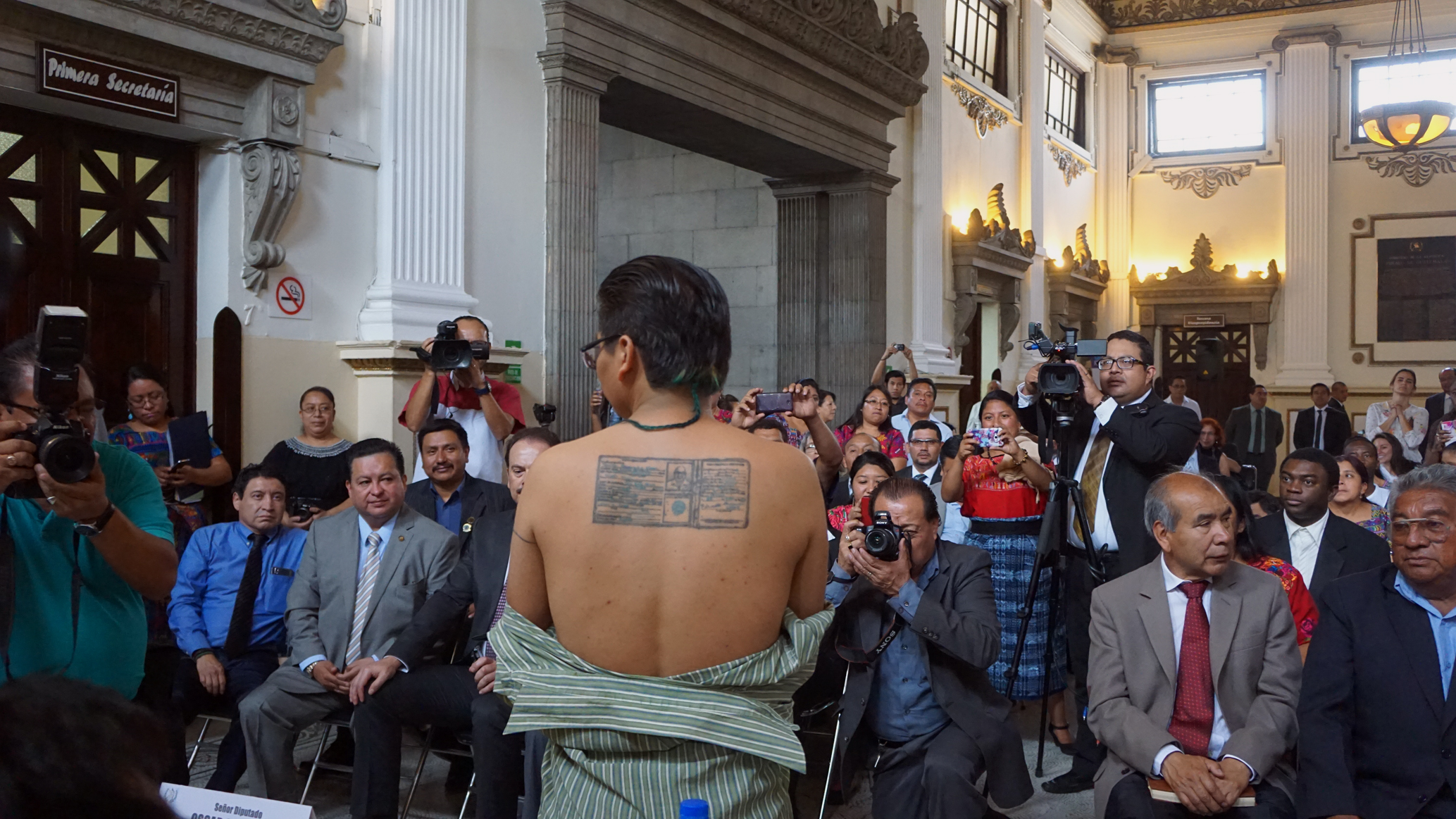
Benvenuto Chavajay, Doroteo Guamuche, 2013. Photographs, tattoo, name reclamation campaign. Performance in Guatemalan Congress.
It is for this reason that the aesthetic must be defended. What should be celebrated is not the apparent triumph of the artwork, but its failure. This way, the piece does not become a realized objective, but comes to exist in its self-contradiction. A similar phenomenon can be discerned in the Zapatista Movement of the Liberación Nacional in Mexico, great differences aside. This phenomenon is achieved from a contemporary notion of emancipation, in which present, past, and future live together, retaking apparently forgotten symbols, and again the history of the ideas is not the same as that of the objects (the world). The EZLN was ahead of its time; it was not present, nor past; it was a distortion of time.
The republican history in Mexico is traversed by a logic of development which polarized the north and the south of the country—the latter region being where the majority of the indigenous population is concentrated, along with the highest rates of poverty and exclusion. With the first Zapatista manifesto and Subcomandante Marcos’s well-known speech, a before and after were marked in the history of contemporary social movements in Latin America. The new movements came to be characterized by their critique of many of the logics of the traditional left (hierarchies, cults of personality, and the Leninist logic of the seizing of the State as a revolutionary project). The Zapatistas retook an emblematic figure of the revolutionary movement of the south in the first decades of the twentieth century: Emiliano Zapata.
One of the most important features of Zapatismo—without forgetting its autonomist political strategy—is the construction of a particular form of the aesthetic; in this case the poetry of discourse and Zapatista visuality acquire a central place. EZLN’s speeches are loaded with hyperboles, semantic games, and metaphors that twist “criteria of truth” on which revolutionary discourses usually find their foundation. The Zapatista image emerges from a search for an imaginary that projects a vision of the world with its own features and a particular cosmovision, and this search takes place as much in the children’s books that Marcos writes as in the mural paintings in the autonomous communities (known as Caracoles). In this way, there is a close relationship between the aesthetic and life, because daily life is political.
Racism’s historical performativity is interrupted by the word, the event, and the daily routine. In 1994, in relation to time and the rhythms of history, the EZLN proposed: “Liberty is like the morning. There are some who wait for it asleep, but there are those who go without sleep and walk through the night to reach it. I [Marcos] say that we the Zapatistas are the addicts of insomnia that history awaits.”8
In relation to history and time, the Zapatistas declared:
[H]istory is no more than doodles that men and women write on the ground of time. Power writes its doodle, praises this doodle as if it was sublime writing, adores it like a unique truth. The mediocre limit themselves to reading the doodles. The fighter smudges out the pages. The excluded do not know how to write . . . yet.
With Benvenuto Chavajay, as with the EZLN, there is a staging of the common. This is not reduced to what we could understand as public art or political art, because its influence has more to do with time than with the object. It has to do with the aesthetic as much as with politics. In both cases, there is a production of a non-linear time, a construct that recovers the past in the present through the transformation of an idea-time. And in this case there is also the affirmation of subjects that don’t subscribe to white-civilized “creolization.”

In Mar Cerrado (Closed Sea), his most recent work, Adrian proposes a posthumous ritual dedicated to the recent history of oil theft in the Pacific Ocean. The project superimposes the Caduceo, the caduceus—a symbol of the mast structure of the emblematic ship Vapor-Guayas—on a sea buoy, as a warning sign. This device will be transported to the place where the first oil spill happened in the jurisdiction of the Ecuadorian State. The project looks to question the complex structure of the political economy in Ecuador, which has been built on the mercantile value of oil as one of the founding elements of the country’s economy.
How can an action developed in the twenty-first century generate this connection in time? How is it that the Greek symbol relates to a decade-old oil spill and a maritime buoy planted in the Pacific Ocean? Is art not a privileged place to think about these types of temporal experiments? The teleology of history is questioned with symbols that work—again—as historic arrhythmias. It is not a matter of historic memory thought from a certain accumulative vindication. In this case, what matters more is to “invent” an evanescent present. The buoy is not the accumulation of memory; it is a type of black hole in the lineal time of history. The aesthetic—as Zapatismo has it—is not a rewriting of other narratives of history. It is in a certain way the very opposite of this: refusing to write.9
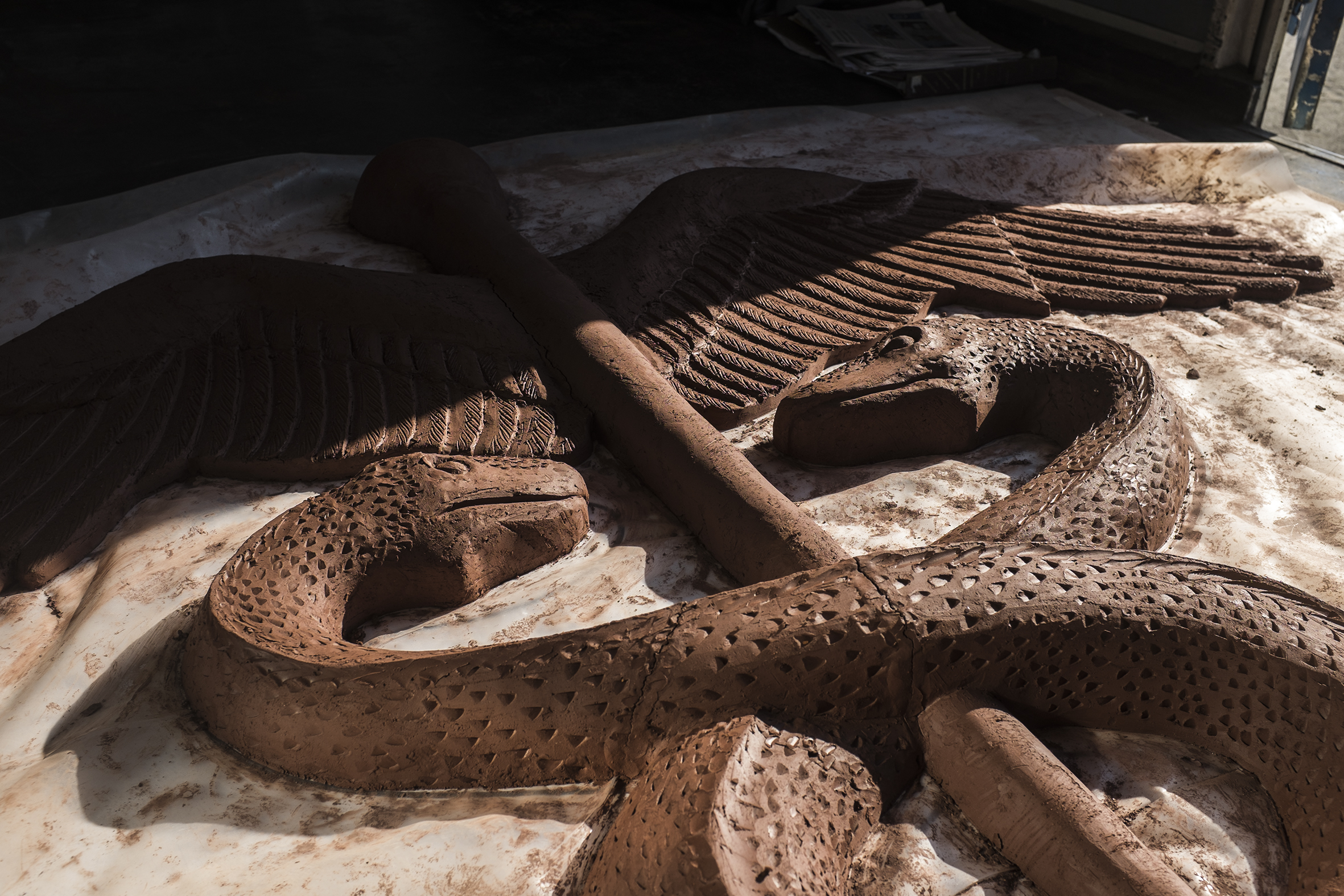
Adrián Balseca Mar cerrado 2016 Video stills Courtesy of the artist
and overlap. This is what artists like Chavajay or Balseca achieve. They question the present as accumulation, proposing aesthetic events that are difficult to reduce to objects, because as museographic-works these remain incapable of encapsulating the totality of the experience. Their aesthetic events situate themselves in an idea of contemporaneity as complex time.
I understand the ideas I’m presenting here as mere approximations. As notes, they may err on the side of being too abstract, which is what thinking about time ultimately is. An abstraction which seems we can access exclusively from an interpretation of the historic, that is to say that time “explains” itself from the beginning of its line, its measurement, its historization. Nevertheless, what I propose is to try to think of time from a certain materiality and aesthetic event, whether this starts with an artwork or with a social movement, hoping that this can contribute or at least incite more non-historicizing reflections from Latin American art. Maybe then, we could actually travel back in time.
Pablo José Ramírez is a curator and political theorist from Guatemala, currently based in London.
_______________
1 The government of Arbenz Guzman was the second of the so called “Democracy Spring” in the country, which propelled a political modernization of the state, redistribution of the possession of the land, and constitutional reforms related to diverse social guarantees.
2 The United Fruit Company in Guatemala, as in other countries of the region, directly supported counterrevolutionary movements, financing militias and giving technical support in direct coordination with the CIA
3 More than a simple “mistake” by the reporter, this name-change reiterates the historic performativity of racism, almost cartoon-like in the use of language. A small decision of the reporter is re-staged by the State and so the figure of the national hero must be creoled or “creolized” (from the word creole) to be written as history.
4 Chunches, in popular Guatemalan jargon, names a type of dysfunctional object—a useless object, a thing.
5 To know more about Chavajay´s work, see the catalogue of the exhibition MUXU´X, curated by Pablo José Ramirez. MUXU´X of Origen and Disobedience, 2015, Editorial Ciudad de la Imaginacion, Guatemala.
6 When the initiative is approved, Benvenuto discloses in social media: “[T]hanks to “El Zurdo” (Miguel Angel Sandoval) for being the curator of this piece.” With this comment, the artist states, I think, a critical attitude towards the specialization of the art system, but more importantly, he implicitly makes a case for the amplified field of the aesthetic event.
7 Emiliano Zapata Salazar (1879-1919) was one of the most important military and campesino leaders and military ideologists of the Mexican Revolution, and he led the Southern Army. He was behind the thrust of the social fights and rural demands against the latifundium and the Porfirian oligarchy.
8 In regard to this, Giorgio Agamben mentions in his well-known essay about contemporariness: “[T]his lack of coincidence, this interval does not mean, obviously, that contemporary is he who lives in a different time, a nostalgic that is better in the Athens of Pericles, or in the Paris of Robespierre and the Marquis de Sade than in the city or in the time in which he had to live . . . The contemporariness is in that singular relation with time itself, that adheres to it, but, at the same time, takes distance from it; more specifically, it is the relation with time that adheres to him through an anachronism and mismatch,” and lastly, in regard to light and obscurity, he mentions: “Contemporary can be said only by he who does not let himself be blinded by the lights of the century and is able to distinguish the shadows in them, his intimate obscurity.”
9 The historic way of thinking cannot go without writing as fiction. Limiting itself to writing history from the hegemony or from a certain subaltern history. Nevertheless, the aesthetic issue, while crossed by subjectification and the symbolic, works in historic terms more as an interruption than as memory. As silence, more than speech.










